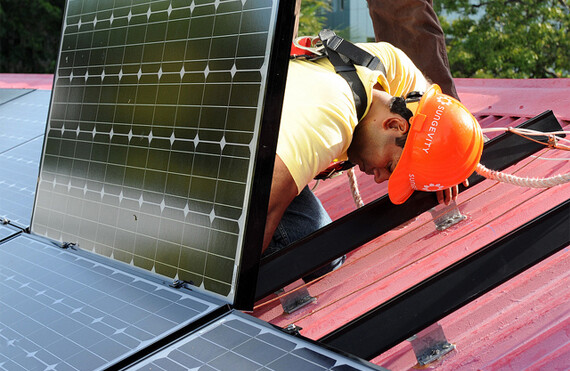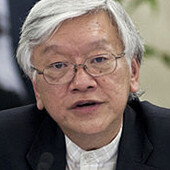Amid the gloomy news in the deteriorating climate change situation is this bright spark: The cost of solar energy has been going down dramatically. This source of clean and renewable energy is seen as one of the major saviors that could help power the world without emitting greenhouse gases.
The drawback is that solar energy has traditionally been more expensive to use than carbon-intensive coal or oil. But in recent years solar power has become much cheaper. Energy experts predict that its cost could match that of conventional fuels in the next few years in some areas.
Solar cell prices have been falling, from $76 per watt in 1977 to about $10 in 1987, and only 74 cents in 2013. Between 2006 and 2011, Chinese solar cell prices dropped 80 percent from $4.50 per watt to 90 cents per watt. Factors for this include a drop in price of the main raw material polysilicon (due to oversupply), the increasing efficiency of solar cells, manufacturing technology improvements, economies of scale, and intense competition.
The use of solar energy has shot up as the cost goes down. Global installed capacity jumped by 28.4 gigawatts in 2012 to reach 89.5 GW. The 100 GW milestone will be crossed sometime this year.
All this is good news for the fight against climate change. Now comes the bad news. The growing global demand has prompted the rise of solar panel manufacturers, and the competition is fierce, with a number of companies facing closure. China's biggest solar energy company Suntech is in serious trouble.
But China has even bigger problems. The United States government, receiving complaints from U.S. solar panel manufacturers, has slapped high anti-dumping tariffs on Chinese imports. Now the European Commission is also planning trade action against Chinese solar products which it claims are selling below cost.
China is taking these threats seriously. Premier Li Keqiang in a visit to Europe last week took up the issue with European leaders. Senior trade officials say China will retaliate. A full-scale trade war is thus imminent.
In a surprising turn of events, Germany and 16 other European countries have told the European Commission they are against its move. Despite this, on June 4 the EC Trade Commissioner Karel De Gucht slapped on tariffs averaging 11.8 percent. De Gucht threatened to raise this to 47.6 percent in August if China does not act to the satisfaction of the EC. The next day, China announced it was investigating why some imported European wines are selling so cheaply in China, undermining domestic wines.
Solar protectionism would be bad for trade, the solar industry, and the environment.
So the solar wars between China with Europe and the United States will likely proceed for some time. This is a real pity, as the commercial interests of the countries are getting in the way of rapid progress in solar energy and the fight against climate change. The expansion of the solar panel industry in China has played a crucial role in getting prices down, making solar energy more and more competitive, and driving its explosive growth.
Yes, China subsidizes and promotes its solar industry. But the United States and Europe also provide massive subsidies and supports. The United States has provided its solar companies with loan guarantees, research grants, and tax deductions including investment tax credits and accelerated value depreciation.
European countries have given subsidies to consumers using solar energy, and incentives to producers including through the feed-in tariff scheme, in which solar energy providers are paid prices higher than what is charged to electricity users with the price difference being met by government.
Without the subsidies, the solar industry would not have grown. Trade protectionist measures taken by one against the other, or by all against others, would be a recipe for disaster—for trade, the solar industry, and the environment.
Well-known solar energy advocate and chairman of Solarcentury Jeremy Leggett uses the following analogy to illustrate the trade war: "A planet faces an asteroid strike. Its inhabitants manufacture rockets with which to head off the threat. But, as the rock nears, they descend into international bickering over who pockets what from rocket-making."
No one wins in this trade war, explains Leggett, because of the global solar supply chain. Solar ingots, the upstream feedstock, are mostly made in Europe and America. The midstream products, cells and modules, are mostly made in China. If China is hit on the midstream products it exports, it could retaliate with tariffs on its imports of upstream products.
"Downstream, the many companies installing solar at scale can only watch in horror," says Leggett. "Everybody loses."
For example, in Europe, the tariffs against China would wipe out thousands of jobs because most are not in manufacturing but in the companies that install the modules, regardless of where they are made.
The solution, he adds, is for the leaders of the few countries where most solar is manufactured to make a deal that coordinates the subsidies required in the various parts of the solar chain, and which is required for the few years that some countries need to bring the price of solar energy to parity with that of conventional energy.
An apt conclusion is made by Leggett: "The world will have to embrace common security on a bigger scale. Engaging in international competition while clinging to the illusion that markets always work will never solve our common problems of energy insecurity, poor air quality, and resource depletion, never mind development. We will keep on maiming industries that can save us."




